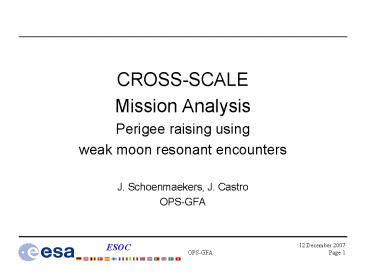CROSSSCALE PowerPoint PPT Presentation
1 / 21
Title: CROSSSCALE
1
- CROSS-SCALE
- Mission Analysis
- Perigee raising using
- weak moon resonant encounters
- J. Schoenmaekers, J. Castro
- OPS-GFA
2
Overview
- Mission requirements
- Operational orbit
- 3 impulse transfer
- Strategy
- Results
- Eclipse mitigation
- Conclusion
3
Mission Requirements
- Primary target magnetotail between 10 and 25 Re
- Secondary target Magnetopause, Bowshock
- Launch by Soyuz-Fregat in GTO with inclination of
14 deg - S/C in operational orbit between 10 (minimum)
to 12 (optimal) - Lifetime 3 year (nominal) 2 year (extension)
- Orbit disposal at end of mission to remain
outside GEO ring - Payload commissioning 6 months with apogee in
solar wind
4
Operational orbit
- Ra 25 Re
- Rp 1.4 / 4.0 / 10 Re
- Inc 14 deg
- W 0 deg
- w 270 deg (winter)
- w 0 deg (spring)
- w 90 deg (summer)
- w 180 deg (autumn)
sun
equator
5
Operational orbit Rp influence
6
3 impulse transfer
7
3 impulse transfer
8
Strategy effect of moon perturbation
- Ra gt 300 tkm
- S/C at apogee
- S/C 10-20 deg behind Moon
- Moon below, in or above orbit
- T gt Rp increase
- W gt Plane rotation
- S gt Ra increase
- S gt Line of apsides rotation
9
Strategy Overview
- 4 moon encounters 15 deg behind moon
- 3 to 1 resonance gt Ra 54 Re
- Moon encounters successively raises Rp to 10 Re
- Apogee tuning DV to synchronise period for next
encounter
- Plane change DV at 1st encounter if moon
out-of-plane to keep launch inclination of 14 deg - Moon inclination increases from 18 deg in 2015 to
29 deg in 2025 gt Plane change DV increases for
later years
10
Strategy influence of sun perturbation
1x54 Re gt DRp max 1146 km / rev 10x54 Re gt
DRp max 4059 km / rev
DRp gt 0
DRp lt 0
Launch
Solar wind
Payload commissioning
Mid-tail crossing
DRp lt 0
DRp gt 0
Transfer
Deployment
11
Results 10 x 25 Re Winter
12
Results 10 x 25 Re - Winter
13
Results 10 x 25 Re - Winter
14
Results 10 x 25 Re - Winter
15
Results 10 x 25 Re - Winter
16
Results 10 x 25 Re - Winter
17
Results launch in 2015
18
Results launch in 2015 to 2019
19
Eclipse mitigation
- Long eclipses occur when the S/C passes through
the earth shadow cone at low speed, i.e. when
the - S/C is near apogee,
- apogee is high,
- apogee is close to the ecliptic plane,
- sun is opposite to the apogee direction.
- During resonances, the apogee is high (54 Re)
- By launching 1 year before the mid-tail crossing,
the sun is opposite to the apogee at the first
encounter - For the spring and autumn cases the apogee is
close to the ecliptic plane - The longest eclipses are thus expected for the
spring and autumn cases - Long eclipses are mitigated by launching 1 month
later so that the sun is already 30 deg past the
anti-apogee direction gt the sun perturbation is
less effective to raise the perigee gt larger
DeltaV (up to 38 m/s) - Long eclipse mitigation only needed for low
DeltaV (spring and autumn) cases so that worst
case DeltaV is not increased
20
Eclipse mitigation
21
Conclusion
- Launch in GTO at 14 deg inclination 1 year before
mid-tail crossing - Transfer to 10 x 25 Re between 12 and 9 months
before mid-tail crossing using 4 moon encounters - Deployment and payload commissioning between 9
and 3 months before mid-tail crossing when S/C in
solar wind - Launch in 2015 DV from 959 to 1040 m/s (direct
1300 m/s) - Spring/autumn gt lowest DV, independent off
launch year - Winter/summer gt highest DV, increasing with
launch year due to increasing inclination of moon
orbit gt 1040 m/s (2015), 1056 m/s (2016), 1075
m/s (2017), 1108 m/s (2018), 1125 m/s (2019) - If launch inclination slightly above inclination
of the moon orbit (2015 20 deg 2025 30 deg) gt
no plane change manoeuvre gt no extra DV for
winter/summer, but lower launch mass - Spring/autumn gt eclipse mitigation to 3.5 hours
for lt 38 m/s - Higher Rp (e.g. 11-12 Re) only slightly more DV

